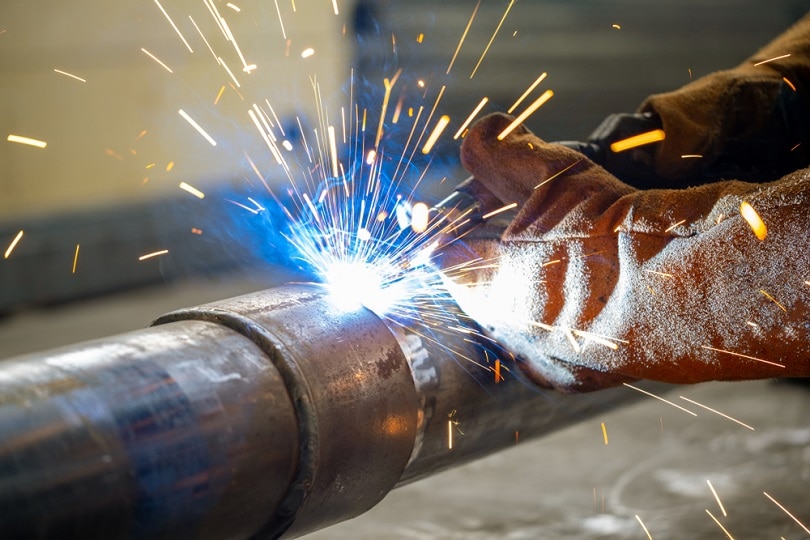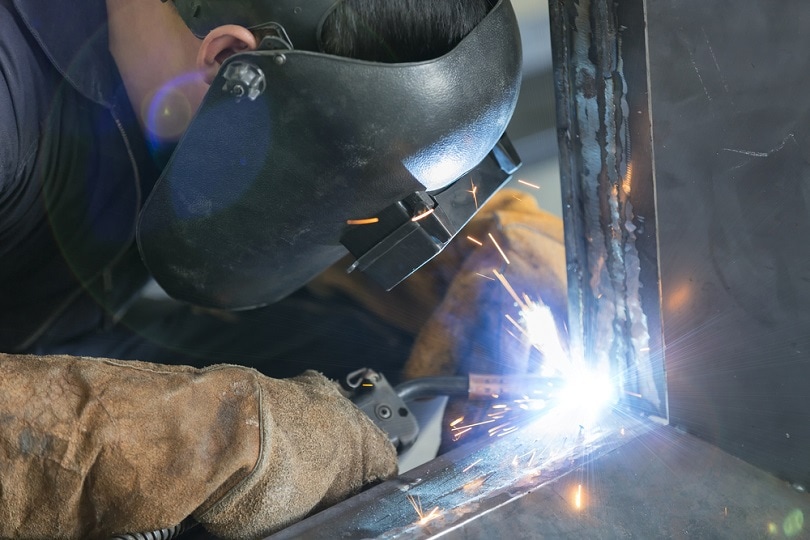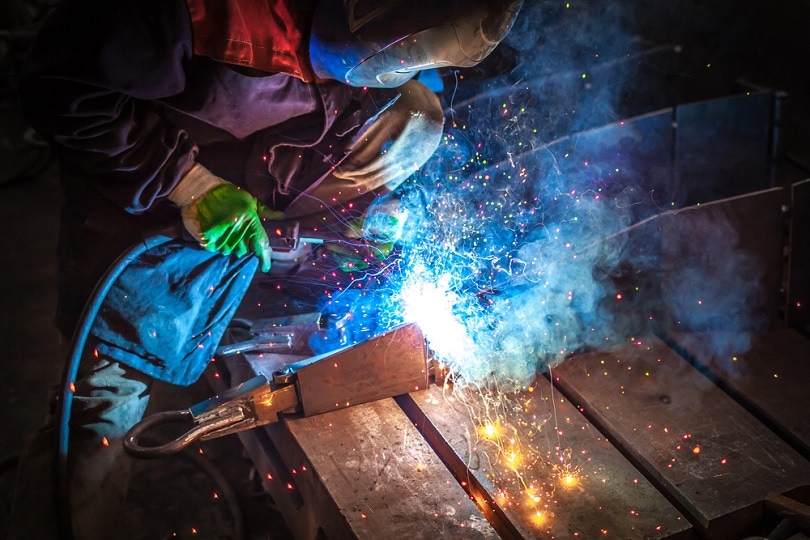What is MIG Welding Used For? A Complete Guide
Last Updated on

If you’re an experienced expert MIG welder, then you’ll know the response to this query, “What is MIG welding used for?” Perhaps you’ve been asked this question often than you can remember.
However, for beginners in welding, or those who would like to transit to MIG welding from stick welding or oxy-fuel, here’s an overview of what MIG welding is used for and why it’s so versatile.
Metal Inert Gas (MIG) Welding
The device fills in the area where two metals are connected. In this procedure, the welder doesn’t require changing the anodes in between their welding jobs. As a welder, fill in the joint that you’re welding and proceed to the next.
- MIG welding power supply that generates electricity to produce heat.
- A wire feed system that generally feeds the cable from the weld joint to the spool.
- A handle that has a trigger that regulates the wire feeder feeding the cable on the weld joint and spool
- Shielding gas-guards. These are the welder’s weld from the air.
Metal Inert Gas Welding works well if you use sheet metals.

Characteristics of the MIG Welding Procedure
MIG welding is an all-round technique fit for both thick and slender section parts. An arc is hit between the workpiece and the terminal of the wire anode, thawing the two of them to create a weld pool.
The cable acts as filler metal for the welding joint and a source of heat. The cable is fed via a contact tip (copper contact tube) that carries current into the cable.
The MIG welding pool is also safeguarded from the surrounding ambiance by a protective gas passed via a nozzle encircling the cable. The shielding gas you’ll use relies on the material you’ll be welding and the application.
With an engine drive, the cable is fed from a reel, and the welder transports the welding torch along the connection line. The cables can be cored (compounds created from a metal sheath using a metal filling or powdered flux) or solid (simple sketched lines).
Usually, consumables are available at competitive costs as compared to other procedures. The wire is constantly fed and, therefore, the procedure provides high productivity. The source of power regulates the wire feed rate and length of the arc.
Nonetheless, the position of the wire and the travel speed is under manual regulation. This is why manual MIG welding is frequently referred to as a semi-automatic procedure. If a welder doesn’t regulate all the procedure parameters, they can mechanize the process.
Nevertheless, it may still need manual adjustment when welding. The procedure can be referred to as automatic if there’s no manual intervention required when welding.
Generally, the process works with the cable positively charged and plugged into a source of power, providing a continuous voltage. The choice of wire diameter (generally from 0.6-1.6mm) and the speed of the wire feed determine the current used in welding. It’s because the cable’s rate of burn-out will create a balance with the feed speed.
What is MIG Welding Used For?
GMAW (Gas Metal Arc Welding) also known as MIG welding is fit for smaller, somewhat lower-volume tasks. It’s manual welding that occurs in and around industries and metalworking plants. It’s where the susceptibility of MIG welding to draughts isn’t much of a problem.
If you’re manufacturing small structures or fixing client’s vehicles, speed, quality of the weld, and high productivity is crucial. And, this is where MIG welding comes in.
Likewise, avocation welders who work on weekend projects in a garage or garage can use MIG welding. Beginner welders, who require good welding capability without TIG’s steeper learning curve or the conventional (and burdensome) oxy-fuel welding, also require MIG welding.
MIG welding is renowned for long-pass capability, cleanliness, applicability to alloys and metals as distinct as stainless steel, mild steel, magnesium, and aluminum. For these reasons, it’s easy to see why this welding procedure has emerged to be a darling of small and medium-sized industries.
MIG Welding Applications
These days, MIG welding is used almost everywhere in the welding industry. Heavy and medium-sized industries such as pipelines, ship construction, pressurized vessels, makers of steel structures, as well as repair and maintenance companies use MIG welding.
Metal Inert Gas Welding is also commonly used in sheet metal factories, especially in the vehicle industry, small industries, and body shops. Home users and hobbyists also usually have a MIG welding machine.

Where MIG Welding isn’t So Perfect
There are no welding approaches ideal for every welding application, and MIG welding isn’t an exception. One of the drawbacks of MIG welding is that it’s not ideal for agricultural or building applications.
It’s because the two have to take place in an open place, or the middle of an exposed field, when the wind is blowing. Windshields can indeed facilitate it. Nevertheless, MIG welding is best suited to the more regulated surroundings of a confined industry or welding shop.
Welders and Other Gear used in MIG Welding
Usually, MIG welding gear includes a source of power, ground wire, wire feeder, elective liquid cooling device, and a protective gas tank or gas network interconnection. The wire feeder feeds the welding cable required in welding from the coil’s spool to the welding gun.
The wire feeder also permits stopping and starting the source of power. If you’re using it as the electronic source of power, you can regulate the voltage offered by the source of power. Therefore, the source of power and the wire feeder are plugged in using a control wire.
Besides, the wire feeder regulates the shielding gas flow. The protective gas required in welding is procured either from a gas network or from a gas tank. Some welding devices are frequently modular in structure, and you can choose the wire feeder, source of power, and the cooling device freely as per your needs.
You can disconnect the wire feeder from the source of power and, therefore, make it needless to transport the whole welding machine from one construction site to the other. The devices also come with a replaceable regulation panel and extra features that are actuated separately.
When welding, the welding gun heats up. Therefore, you have to cool it using a gas or liquid. In the case of gas-cooled welding guns, the protective gas that flows to the gun via the welding wire and at the same time serves as a gun cooler.
A separate liquid cooling device is needed to reuse the cooling liquid in the welding wire to the gun in liquid-cooled guns. The structure of a MIG welding device is limited to the welding cable coil in the machine.
The coil is frequently hefty and takes a lot of room. Nevertheless, the most contemporary MIG welding machines are elegant and compact.
Tips on MIG Welding
- Understand Your Metal
For instance, if you’ll be MIG welding aluminum, you’ll be using a distinct welding procedure than welding copper. Before you start, it’s good to understand how every metal you’ll weld will react to the welding procedure.
- Utilize Your Two Hands
To direct the weld and achieve a cleaner finish, don’t be afraid to bring your hand into play. Ensure that you get the best spark and heat resistant welding gloves you can purchase, and your hands will be okay.
- Ensure You Replace the Contact Tips
Contact tips aren’t only affordable but also require easy replacement. If you observe one of them going out, then replace it before it causes disarray to your weld. Ensure that you have additional tips in your bag of welding machinery.
Components of MIG Welding
- The source of power – It’s typically Direct Current with a constant voltage.
- Cable – The wire feed system needs to operate smoothly so that your welding can be uniform. Feeding systems comprise push-pull, spool-on-gun, and pinch rolls.
- The anode – You have to get the correct diameter and constitution of the weld as per your project.
- The welding torch – Supplies the gases that safeguard the arc and weld pool and moves the welding current to the cable. Torches can either be water-cooled or air-cooled. Usually, air-cooled torches are inexpensive and lighter as compared to water-cooled torches. They utilize the gas flowing through them to make the nozzle cool. Torches are fit for lighter welding projects. If a welder is using high current and carrying out heavy tasks, then water-cooled guns are the best bet.
- Gas protection – The gas that safeguards the weld pool and the arc typically comprises Carbon Dioxide and Argon.
- The filler metal – Helps strengthen what you’re welding and conducts electric current used to melt the anode.
- Conduit – Ensure that the Conduit is straight and short so that feeding can take place hassle-free.
MIG Welding: A Flexible Solution to your Manufacturing and Repair/Maintenance Requirements
Metal Inert Gas welding is an arc welding procedure in which an incessant solid cable anode is fed into a weld pool via a welding gun, connecting the two-parent metals. A protective gas is passed through the welding gun and safeguards the weld pool from getting contaminated.
Gas Metal Arc Welding (GMAW) is the technical name for MIG welding, and the lingo for it is wire welding. Using the MIG welding procedure, a farmer, motorsports fanatic, home-hobbyist, or DIYer can produce many fabrication types and repair welds on metal starting from 24-gauge to ½ -inch thick.
Besides suppleness, most people prefer GMAW as they’ve heard that it’s easy to learn. Although it isn’t that easy, numerous people may indeed become proficient if they follow some basic advice.
Featured image credit: Danil Evskyi, Shutterstock
